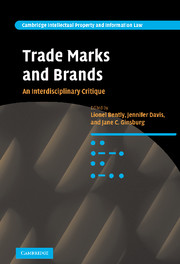Book contents
- Frontmatter
- Contents
- List of figures and tables
- Notes on the contributors
- Editors' preface
- Table of cases
- Table of statutes
- Part I Legal and economic history
- Part II Current positive law in the EU and the USA
- Part III Linguistics
- Part IV Marketing
- 7 Brand culture: trade marks, marketing and consumption
- 8 ‘Brand culture: trade marks, marketing and consumption’ – responding legally to Professor Schroeder's paper
- Part V Sociology
- Part VI Law and Economics
- Part VII Philosophy
- Part VIII Anthropology
- Part IX Geography
- Bibliography
- Index
- Titles in the series
7 - Brand culture: trade marks, marketing and consumption
Published online by Cambridge University Press: 13 April 2010
- Frontmatter
- Contents
- List of figures and tables
- Notes on the contributors
- Editors' preface
- Table of cases
- Table of statutes
- Part I Legal and economic history
- Part II Current positive law in the EU and the USA
- Part III Linguistics
- Part IV Marketing
- 7 Brand culture: trade marks, marketing and consumption
- 8 ‘Brand culture: trade marks, marketing and consumption’ – responding legally to Professor Schroeder's paper
- Part V Sociology
- Part VI Law and Economics
- Part VII Philosophy
- Part VIII Anthropology
- Part IX Geography
- Bibliography
- Index
- Titles in the series
Summary
Visual images constitute much corporate communication about products, economic performance and social responsibility, and also inform governmental efforts to create positive attitudes for citizens, consumers and organizations. Brand image, corporate image, advertising images and images of identity all depend upon compelling visual imagery. Variously referred to as the attention economy, the aesthetic economy and the experience economy, this visual turn in marketing may call for rethinking traditional approaches to brands and trade marks. Branding's reliance on visual rhetoric brings up a host of interdisciplinary questions. How do images function within marketing communication? What does the production and consumption of images mean for marketing, law and society? How does the handling of images in the allied fields of visual studies, art history, film theory, design management and corporate identity shed light on the relationships between visual images, brands and consumption?
This chapter discusses methodological and theoretical issues of visual images as they pertain to brands, via interdisciplinary research examples and exemplars. I place visual issues within a broader theoretical perspective of brand culture – the cultural dimensions or codes of brands (history, images, myths, art, theatre) that influence brand meaning in the marketplace. Visual consumer research cuts across methodological and topical boundary lines – the possibilities and problems of visual approaches encompass experimental and interpretive realms, and include such varied topics as information processing, image interpretation and research techniques.
- Type
- Chapter
- Information
- Trade Marks and BrandsAn Interdisciplinary Critique, pp. 161 - 176Publisher: Cambridge University PressPrint publication year: 2008
- 8
- Cited by



